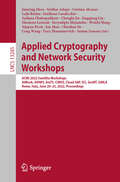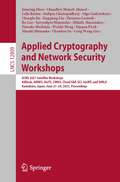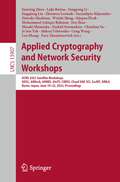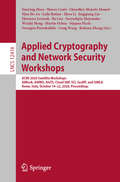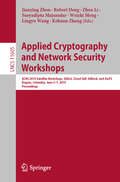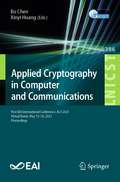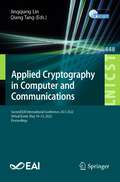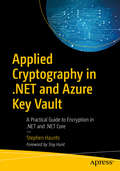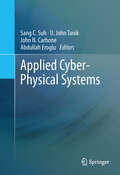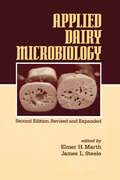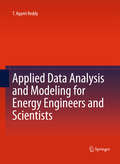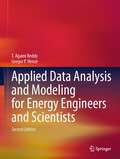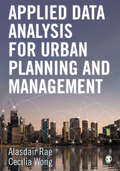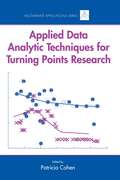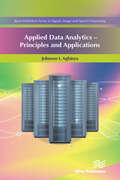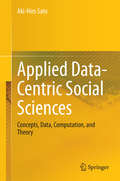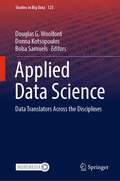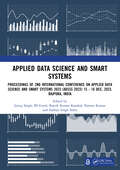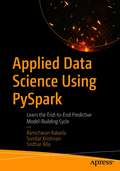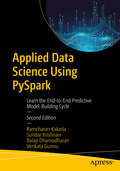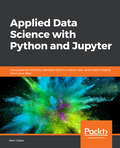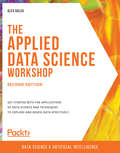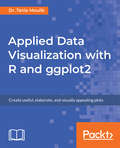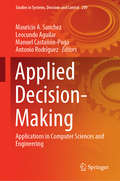- Table View
- List View
Applied Cryptography and Network Security Workshops: ACNS 2022 Satellite Workshops, AIBlock, AIHWS, AIoTS, CIMSS, Cloud S&P, SCI, SecMT, SiMLA, Rome, Italy, June 20–23, 2022, Proceedings (Lecture Notes in Computer Science #13285)
by Jianying Zhou Sridhar Adepu Cristina Alcaraz Lejla Batina Emiliano Casalicchio Sudipta Chattopadhyay Chenglu Jin Jingqiang Lin Eleonora Losiouk Suryadipta Majumdar Weizhi Meng Stjepan Picek Jun Shao Chunhua Su Cong Wang Yury Zhauniarovich Saman ZonouzThis book constitutes the proceedings of the satellite workshops held around the 20th International Conference on Applied Cryptography and Network Security, ACNS 2022, held in Rome, Italy, in June 2022. Due to the Corona pandemic the workshop was held as a virtual event. The 31 papers presented in this volume were carefully reviewed and selected from 52 submissions. They stem from the following workshops:– AIBlock: 4th ACNS Workshop on Application Intelligence and Blockchain Security– AIHWS: 3rd ACNS Workshop on Artificial Intelligence in Hardware Security– AIoTS: 4th ACNS Workshop on Artificial Intelligence and Industrial IoT Security– CIMSS: 2nd ACNS Workshop on Critical Infrastructure and Manufacturing System Security– Cloud S&P: 4th ACNS Workshop on Cloud Security and Privacy– SCI: 3rd ACNS Workshop on Secure Cryptographic Implementation– SecMT: 3rd ACNS Workshop on Security in Mobile Technologies– SiMLA: 4th ACNS Workshop on Security in Machine Learning and its Applications
Applied Cryptography and Network Security Workshops: ACNS 2021 Satellite Workshops, AIBlock, AIHWS, AIoTS, CIMSS, Cloud S&P, SCI, SecMT, and SiMLA, Kamakura, Japan, June 21–24, 2021, Proceedings (Lecture Notes in Computer Science #12809)
by Jianying Zhou Chuadhry Mujeeb Ahmed Lejla Batina Sudipta Chattopadhyay Olga Gadyatskaya Chenglu Jin Jingqiang Lin Eleonora Losiouk Bo Luo Suryadipta Majumdar Mihalis Maniatakos Daisuke Mashima Weizhi Meng Stjepan Picek Masaki Shimaoka Chunhua Su Cong WangThis book constitutes the proceedings of the satellite workshops held around the 19th International Conference on Applied Cryptography and Network Security, ACNS 2021, held in Kamakura, Japan, in June 2021.The 26 papers presented in this volume were carefully reviewed and selected from 49 submissions. They stem from the following workshops: AIBlock 2021: Third International Workshop on Application Intelligence and Blockchain Security AIHWS 2021: Second International Workshop on Artificial Intelligence in Hardware Security AIoTS 2021: Third International Workshop on Artificial Intelligence and Industrial IoT Security CIMSS 2021: First International Workshop on Critical Infrastructure and Manufacturing System Security Cloud S&P 2021: Third International Workshop on Cloud Security and Privacy SCI 2021: Second International Workshop on Secure Cryptographic Implementation SecMT 2021: Second International Workshop on Security in Mobile Technologies SiMLA 2021; Third International Workshop on Security in Machine Learning and its ApplicationsDue to the Corona pandemic the workshop was held as a virtual event.
Applied Cryptography and Network Security Workshops: ACNS 2023 Satellite Workshops, ADSC, AIBlock, AIHWS, AIoTS, CIMSS, Cloud S&P, SCI, SecMT, SiMLA, Kyoto, Japan, June 19–22, 2023, Proceedings (Lecture Notes in Computer Science #13907)
by Jianying Zhou Lejla Batina Zengpeng Li Jingqiang Lin Eleonora Losiouk Suryadipta Majumdar Daisuke Mashima Weizhi Meng Stjepan Picek Mohammad Ashiqur Rahman Jun Shao Masaki Shimaoka Ezekiel Soremekun Chunhua Su Je Sen Teh Aleksei Udovenko Cong Wang Leo Zhang Yury ZhauniarovichThis book constitutes the proceedings of the satellite workshops held around the 21st International Conference on Applied Cryptography and Network Security, ACNS 2023, held in Kyoto, Japan, in June 2023.The 34 full papers and 13 poster papers presented in this volume were carefully reviewed and selected from 76 submissions. They stem from the following workshops: · 1st ACNS Workshop on Automated Methods and Data-driven Techniques in Symmetric-key Cryptanalysis (ADSC 2023) · 5th ACNS Workshop on Application Intelligence and Blockchain Security (AIBlock 2023) · 4th ACNS Workshop on Artificial Intelligence in Hardware Security (AIHWS 2023) · 5th ACNS Workshop on Artificial Intelligence and Industrial IoT Security (AIoTS 2023) · 3rd ACNS Workshop on Critical Infrastructure and Manufacturing System Security (CIMSS 2023) · 5th ACNS Workshop on Cloud Security and Privacy (Cloud S&P 2023) · 4th ACNS Workshop on Secure Cryptographic Implementation (SCI 2023) · 4th ACNS Workshop on Security in Mobile Technologies (SecMT 2023) · 5th ACNS Workshop on Security in Machine Learning and its Applications (SiMLA 2023)
Applied Cryptography and Network Security Workshops: ACNS 2020 Satellite Workshops, AIBlock, AIHWS, AIoTS, Cloud S&P, SCI, SecMT, and SiMLA, Rome, Italy, October 19–22, 2020, Proceedings (Lecture Notes in Computer Science #12418)
by Jianying Zhou Mauro Conti Chuadhry Mujeeb Ahmed Man Ho Au Lejla Batina Zhou Li Jingqiang Lin Eleonora Losiouk Bo Luo Suryadipta Majumdar Weizhi Meng Martín Ochoa Stjepan Picek Georgios Portokalidis Cong Wang Kehuan ZhangThis book constitutes the proceedings of the satellite workshops held around the 18th International Conference on Applied Cryptography and Network Security, ACNS 2020, in Rome, Italy, in October 2020. The 31 papers presented in this volume were carefully reviewed and selected from 65 submissions. They stem from the following workshops: AIBlock 2020:Second International Workshop on Application Intelligence and Blockchain Security AIHWS 2020:First International Workshop on Artificial Intelligence in Hardware Security AIoTS 2020:Second International Workshop on Artificial Intelligence and Industrial Internet-of-Things Security Cloud S&P 2020:Second International Workshop on Cloud Security and Privacy SCI 2020:First International Workshop on Secure Cryptographic Implementation SecMT 2020:First International Workshop on Security in Mobile Technologies SiMLA 2020: Second International Workshop on Security in Machine Learning and its Applications
Applied Cryptography and Network Security Workshops: ACNS 2019 Satellite Workshops, SiMLA, Cloud S&P, AIBlock, and AIoTS, Bogota, Colombia, June 5–7, 2019, Proceedings (Lecture Notes in Computer Science #11605)
by Jianying Zhou Robert Deng Zhou Li Suryadipta Majumdar Weizhi Meng Lingyu Wang Kehuan ZhangThis book constitutes the proceedings of the satellite workshops held around the 17th International Conference on Applied Cryptography and Network Security, ACNS 2019, in Bogota, Colombia, in June 2019. The 10 papers presented in this volume were carefully reviewed and selected from 30 submissions. They stem from the following workshops:AIBlock 2019: First International Workshop on Application Intelligence and Blockchain SecurityAIoTS 2019:First International Workshop on Articial Intelligence and Industrial Internet-of-Things SecurityCloud S&P 2019:First International Workshop on Cloud Security and PrivacyPriDA 2019:First InternationalWorkshop on Privacy-preserving Distributed Data AnalysisSiMLA 2019: First International Workshop on Security in Machine Learning and its Applications
Applied Cryptography in Computer and Communications: First EAI International Conference, AC3 2021, Virtual Event, May 15-16, 2021, Proceedings (Lecture Notes of the Institute for Computer Sciences, Social Informatics and Telecommunications Engineering #386)
by Bo Chen Xinyi HuangThis book constitutes the refereed post-conference proceedings of the First International Conference on Applied Cryptography in Computer and Communications, AC3 2021, and the First International Workshop on Security for Internet of Things (IoT). The conference was held in May 2021 and due to COVID-19 pandemic virtually.The 15 revised full papers were carefully reviewed and selected from 42 submissions. The papers present are grouped in 4 tracks on blockchain; authentication; secure computation; practical crypto application. They detail technical aspects of applied cryptography, including symmetric cryptography, public-key cryptography, cryptographic protocols, cryptographic implementations, cryptographic standards and practices.
Applied Cryptography in Computer and Communications: Second EAI International Conference, AC3 2022, Virtual Event, May 14-15, 2022, Proceedings (Lecture Notes of the Institute for Computer Sciences, Social Informatics and Telecommunications Engineering #448)
by Jingqiang Lin Qiang TangThis book constitutes the refereed post-conference proceedings of the Second International Conference on Applied Cryptography in Computer and Communications, AC3 2022, held May 14-15, 2022 and due to COVID-19 pandemic virtually.The 12 revised full papers and 2 short papers were carefully reviewed and selected from 38 submissions. They were organized in topical sections as follows: quantum-safe cryptographic solution; applied cryptography for IoT; authentication protocol; real-world applied cryptography; network attack and defense; security application.
Applied Cryptography in .NET and Azure Key Vault: A Practical Guide to Encryption in .NET and .NET Core
by Stephen HauntsBenefit from Microsoft's robust suite of security and cryptography primitives to create a complete, hybrid encryption scheme that will protect your data against breaches. This highly practical book teaches you how to use the .NET encryption APIs and Azure Key Vault, and how they can work together to produce a robust security solution. Applied Cryptography in .NET and Azure Key Vault begins with an introduction to the dangers of data breaches and the basics of cryptography. It then takes you through important cryptographic techniques and practices, from hashing and symmetric/asymmetric encryption, to key storage mechanisms. By the end of the book, you’ll know how to combine these cryptographic primitives into a hybrid encryption scheme that you can use in your applications. Author Stephen Haunts brings 25 years of software development and security experience to the table to give you the concrete skills, knowledge, and code you need to implement the latest encryption standards in your own projects.What You'll LearnGet an introduction to the principles of encryptionUnderstand the main cryptographic protocols in use today, including AES, DES, 3DES, RSA, SHAx hashing, HMACs, and digital signaturesCombine cryptographic techniques to create a hybrid cryptographic scheme, with the benefits of confidentiality, integrity, authentication, and non-repudiationUse Microsoft's Azure Key Vault to securely store encryption keys and secretsBuild real-world code to use in your own projectsWho This Book Is ForSoftware developers with experience in .NET and C#. No prior knowledge of encryption and cryptographic principles is assumed.
Applied Cyber-Physical Systems
by Abdullah Eroglu Sang C. Suh John N. Carbone U. John TanikApplied Cyber-Physical Systems presents the latest methods and technologies in the area of cyber-physical systems including medical and biological applications. Cyber-physical systems (CPS) integrate computing and communication capabilities by monitoring, and controlling the physical systems via embedded hardware and computers. This book brings together unique contributions from renowned experts on cyber-physical systems research and education with applications. It also addresses the major challenges in CPS, and then provides a resolution with various diverse applications as examples. Advanced-level students and researchers focused on computer science, engineering and biomedicine will find this to be a useful secondary text book or reference, as will professionals working in this field.
Applied Dairy Microbiology (Food Science and Technology)
by Elmer H. Marth James L. SteeleThis thoroughly revised and updated reference provides comprehensive coverage of the latest developments and scientific advances in dairy microbiology-emphasizing probiotics, fermented dairy products, disease prevention, and public health and regulatory control standards for dairy foods. Containing more than 2350 bibliographic citations, tables, dr
Applied Data Analysis and Modeling for Energy Engineers and Scientists
by T. Agami ReddyApplied Data Analysis and Modeling for Energy Engineers and Scientists fills an identified gap in engineering and science education and practice for both students and practitioners. It demonstrates how to apply concepts and methods learned in disparate courses such as mathematical modeling, probability,statistics, experimental design, regression, model building, optimization, risk analysis and decision-making to actual engineering processes and systems. The text provides a formal structure that offers a basic, broad and unified perspective,while imparting the knowledge, skills and confidence to work in data analysis and modeling. This volume uses numerous solved examples, published case studies from the author's own research, and well-conceived problems in order to enhance comprehension levels among readers and their understanding of the "processes"along with the tools.
Applied Data Analysis and Modeling for Energy Engineers and Scientists
by T. Agami Reddy Gregor P. HenzeNow in a thoroughly revised and expanded second edition, this classroom-tested text demonstrates and illustrates how to apply concepts and methods learned in disparate courses such as mathematical modeling, probability, statistics, experimental design, regression, optimization, parameter estimation, inverse modeling, risk analysis, decision-making, and sustainability assessment methods to energy processes and systems. It provides a formal structure that offers a broad and integrative perspective to enhance knowledge, skills, and confidence to work in applied data analysis and modeling problems. This new edition also reflects recent trends and advances in statistical modeling as applied to energy and building processes and systems. It includes numerous examples from recently published technical papers to nurture and stimulate a more research-focused mindset. How the traditional stochastic data modeling methods complement data analytic algorithmic approaches such as machine learning and data mining is also discussed. The important societal issue related to the sustainability of energy systems is presented, and a formal structure is proposed meant to classify the various assessment methods found in the literature. Applied Data Analysis and Modeling for Energy Engineers and Scientists is designed for senior-level undergraduate and graduate instruction in energy engineering and mathematical modeling, for continuing education professional courses, and as a self-study reference book for working professionals. In order for readers to have exposure and proficiency with performing hands-on analysis, the open-source Python and R programming languages have been adopted in the form of Jupyter notebooks and R markdown files, and numerous data sets and sample computer code reflective of real-world problems are available online.
Applied Data Analysis for Urban Planning and Management
by Cecilia Wong Alasdair RaeThis book showcases the different ways in which contemporary forms of data analysis are being used in urban planning and management. It highlights the emerging possibilities that city-regional governance, technology and data have for better planning and urban management - and discusses how you can apply them to your research. Including perspectives from across the globe, it’s packed with examples of good practice and helps to demystify the process of using big and open data. Learn about different kinds of emergent data sources and how they are processed, visualised and presented. Understand how spatial analysis and GIS are used in city planning. See examples of how contemporary data analytics methods are being applied in a variety of contexts, such as ‘smart’ city management and megacities. Aimed at upper undergraduate and postgraduate students studying spatial analysis and planning, this timely text is the perfect companion to enable you to apply data analytics approaches in your research.
Applied Data Analysis for Urban Planning and Management
by Cecilia Wong Alasdair RaeThis book showcases the different ways in which contemporary forms of data analysis are being used in urban planning and management. It highlights the emerging possibilities that city-regional governance, technology and data have for better planning and urban management - and discusses how you can apply them to your research. Including perspectives from across the globe, it’s packed with examples of good practice and helps to demystify the process of using big and open data. Learn about different kinds of emergent data sources and how they are processed, visualised and presented. Understand how spatial analysis and GIS are used in city planning. See examples of how contemporary data analytics methods are being applied in a variety of contexts, such as ‘smart’ city management and megacities. Aimed at upper undergraduate and postgraduate students studying spatial analysis and planning, this timely text is the perfect companion to enable you to apply data analytics approaches in your research.
Applied Data Analytic Techniques For Turning Points Research (Multivariate Applications Series)
by Patricia CohenThis innovative volume demonstrates the use of a range of statistical approaches that examine "turning points" (a change in direction, magnitude, or meaning) in real data. Analytic techniques are illustrated with real longitudinal data from a variety of fields. As such the book will appeal to a variety of researchers including: Developmental researchers interested in identifying factors precipitating turning points at various life stages. Medical or substance abuse researchers looking for turning points in disease or recovery. Social researchers interested in estimating the effects of life experiences on subsequent behavioral changes. Interpersonal behavior researchers looking to identify turning points in relationships. Brain researchers needing to discriminate the onset of an experimentally produced process in a participant. The book opens with the goals and theoretical considerations in defining turning points. An overview of the methods presented in subsequent chapters is then provided. Chapter goals include discriminating "local" from long-term effects, identifying variables altering the connection between trajectories at different life stages, locating non-normative turning points, coping with practical distributional problems in trajectory analyses, and changes in the meaning and connections between variables in the transition to adulthood. From an applied perspective, the book explores such topics as antisocial/aggressive trajectories at different life stages, the impact of imprisonment on criminal behavior, family contact trajectories in the transition to adulthood, sustained effects of substance abuse, alternative models of bereavement, and identifying brain changes associated with the onset of a new brain process. Ideal for advanced students and researchers interested in identifying significant change in data in a variety of fields including psychology, medicine, education, political science, criminology, and sociology.
Applied Data Analytics - Principles and Applications
by Johnson I. AgbinyaThe emergence of huge amounts of data which require analysis and in some cases real-time processing has forced exploration into fast algorithms for handling very lage data sizes. Analysis of x-ray images in medical applications, cyber security data, crime data, telecommunications and stock market data, health records and business analytics data are but a few areas of interest. Applications and platforms including R, RapidMiner and Weka provide the basis for analysis, often used by practitioners who pay little to no attention to the underlying mathematics and processes impacting the data. This often leads to an inability to explain results or correct mistakes, or to spot errors.Applied Data Analytics - Principles and Applications seeks to bridge this missing gap by providing some of the most sought after techniques in big data analytics. Establishing strong foundations in these topics provides practical ease when big data analyses are undertaken using the widely available open source and commercially orientated computation platforms, languages and visualisation systems. The book, when combined with such platforms, provides a complete set of tools required to handle big data and can lead to fast implementations and applications.The book contains a mixture of machine learning foundations, deep learning, artificial intelligence, statistics and evolutionary learning mathematics written from the usage point of view with rich explanations on what the concepts mean. The author has thus avoided the complexities often associated with these concepts when found in research papers. The tutorial nature of the book and the applications provided are some of the reasons why the book is suitable for undergraduate, postgraduate and big data analytics enthusiasts.This text should ease the fear of mathematics often associated with practical data analytics and support rapid applications in artificial intelligence, environmental sensor data modelling and analysis, health informatics, business data analytics, data from Internet of Things and deep learning applications.
Applied Data-Centric Social Sciences: Concepts, Data, Computation, and Theory
by Aki-Hiro SatoApplied data-centric social sciences aim to develop both methodology and practical applications of various fields of social sciences and businesses with rich data. Specifically, in the social sciences, a vast amount of data on human activities may be useful for understanding collective human nature. In this book, the author introduces several mathematical techniques for handling a huge volume of data and analysing collective human behaviour. The book is constructed from data-oriented investigation, with mathematical methods and expressions used for dealing with data for several specific problems. The fundamental philosophy underlying the book is that both mathematical and physical concepts are determined by the purposes of data analysis. This philosophy is shown throughout exemplar studies of several fields in socio-economic systems. From a data-centric point of view, the author proposes a concept that may change people's minds and cause them to start thinking from the basis of data. Several goals underlie the chapters of the book. The first is to describe mathematical and statistical methods for data analysis, and toward that end the author delineates methods with actual data in each chapter. The second is to find a cyber-physical link between data and data-generating mechanisms, as data are always provided by some kind of data-generating process in the real world. The third goal is to provide an impetus for the concepts and methodology set forth in this book to be applied to socio-economic systems.
Applied Data Science: Data Translators Across the Disciplines (Studies in Big Data #125)
by Douglas G. Woolford Donna Kotsopoulos Boba SamuelsThe use of data to guide action is growing. Even the public uses data to guide everyday decisions! How do we develop data acumen across a broad range of fields and varying levels of expertise? How do we foster the development of effective data translators? This book explores these questions, presenting an interdisciplinary collection of edited contributions across fields such as education, health sciences, natural sciences, politics, economics, business and management studies, social sciences, and humanities. Authors illustrate how to use data within a discipline, including visualization and analysis, translating and communicating results, and pedagogical considerations. This book is of interest to scholars and anyone looking to understand the use of data science across disciplines. It is ideal in a course for non-data science majors exploring how data translation occurs in various contexts and for professionals looking to engage in roles requiring data translation.
Applied Data Science and Smart Systems
by Jaiteg Singh S B Goyal Rajesh Kumar Kaushal Naveen Kumar Sukhjit Singh SehraThe Second International Conference on Applied Data Science and Smart Systems (ADSSS-2023) was held on 15-16 December 2023 at Chitkara University, Punjab, India. This multidisciplinary conference focussed on innovation and progressive practices in science, technology, and management. The conference successfully brought together researchers, academicians, and practitioners across different domains such as artificial intelligence and machine learning, software engineering, automation, data science, business computing, data communication and computer networks. The presenters shared their most recent research works that are critical to contemporary business and societal landscape and encouraged the participants to devise solutions for real-world challenges.The Open Access version of this book, available at www.taylorfrancis.com, has been made available under a Creative Commons [Attribution-Non Commercial-No Derivatives (CC-BY-NC-ND)] 4.0 license.
Applied Data Science Using PySpark: Learn the End-to-End Predictive Model-Building Cycle
by Ramcharan Kakarla Sundar Krishnan Sridhar AllaDiscover the capabilities of PySpark and its application in the realm of data science. This comprehensive guide with hand-picked examples of daily use cases will walk you through the end-to-end predictive model-building cycle with the latest techniques and tricks of the trade. Applied Data Science Using PySpark is divided unto six sections which walk you through the book. In section 1, you start with the basics of PySpark focusing on data manipulation. We make you comfortable with the language and then build upon it to introduce you to the mathematical functions available off the shelf. In section 2, you will dive into the art of variable selection where we demonstrate various selection techniques available in PySpark. In section 3, we take you on a journey through machine learning algorithms, implementations, and fine-tuning techniques. We will also talk about different validation metrics and how to use them for picking the best models. Sections 4 and 5 go through machine learning pipelines and various methods available to operationalize the model and serve it through Docker/an API. In the final section, you will cover reusable objects for easy experimentation and learn some tricks that can help you optimize your programs and machine learning pipelines. By the end of this book, you will have seen the flexibility and advantages of PySpark in data science applications. This book is recommended to those who want to unleash the power of parallel computing by simultaneously working with big datasets. What You Will Learn Build an end-to-end predictive modelImplement multiple variable selection techniquesOperationalize modelsMaster multiple algorithms and implementations Who This Book is For Data scientists and machine learning and deep learning engineers who want to learn and use PySpark for real-time analysis of streaming data.
Applied Data Science Using PySpark: Learn the End-to-End Predictive Model-Building Cycle
by Ramcharan Kakarla Sundar Krishnan Balaji Dhamodharan Venkata GunnuThis comprehensive guide, featuring hand-picked examples of daily use cases, will walk you through the end-to-end predictive model-building cycle using the latest techniques and industry tricks. In Chapters 1, 2, and 3, we will begin by setting up the environment and covering the basics of PySpark, focusing on data manipulation. Chapter 4 delves into the art of variable selection, demonstrating various techniques available in PySpark. In Chapters 5, 6, and 7, we explore machine learning algorithms, their implementations, and fine-tuning techniques. Chapters 8 and 9 will guide you through machine learning pipelines and various methods to operationalize and serve models using Docker/API. Chapter 10 will demonstrate how to unlock the power of predictive models to create a meaningful impact on your business. Chapter 11 introduces some of the most widely used and powerful modeling frameworks to unlock real value from data. In this new edition, you will learn predictive modeling frameworks that can quantify customer lifetime values and estimate the return on your predictive modeling investments. This edition also includes methods to measure engagement and identify actionable populations for effective churn treatments. Additionally, a dedicated chapter on experimentation design has been added, covering steps to efficiently design, conduct, test, and measure the results of your models. All code examples have been updated to reflect the latest stable version of Spark. You will: Gain an overview of end-to-end predictive model building Understand multiple variable selection techniques and their implementations Learn how to operationalize models Perform data science experiments and learn useful tips
Applied Data Science with Python and Jupyter: Use powerful industry-standard tools to unlock new, actionable insights from your data
by Alex GaleaBecome the master player of data exploration by creating reproducible data processing pipelines, visualizations, and prediction models for your applications.Key FeaturesGet up and running with the Jupyter ecosystem and some example datasetsLearn about key machine learning concepts such as SVM, KNN classifiers, and Random ForestsDiscover how you can use web scraping to gather and parse your own bespoke datasetsBook DescriptionGetting started with data science doesn't have to be an uphill battle. Applied Data Science with Python and Jupyter is a step-by-step guide ideal for beginners who know a little Python and are looking for a quick, fast-paced introduction to these concepts. In this book, you'll learn every aspect of the standard data workflow process, including collecting, cleaning, investigating, visualizing, and modeling data. You'll start with the basics of Jupyter, which will be the backbone of the book. After familiarizing ourselves with its standard features, you'll look at an example of it in practice with our first analysis. In the next lesson, you dive right into predictive analytics, where multiple classification algorithms are implemented. Finally, the book ends by looking at data collection techniques. You'll see how web data can be acquired with scraping techniques and via APIs, and then briefly explore interactive visualizations.What you will learnGet up and running with the Jupyter ecosystemIdentify potential areas of investigation and perform exploratory data analysisPlan a machine learning classification strategy and train classification modelsUse validation curves and dimensionality reduction to tune and enhance your modelsScrape tabular data from web pages and transform it into Pandas DataFramesCreate interactive, web-friendly visualizations to clearly communicate your findingsWho this book is forApplied Data Science with Python and Jupyter is ideal for professionals with a variety of job descriptions across a large range of industries, given the rising popularity and accessibility of data science. You'll need some prior experience with Python, with any prior work with libraries such as Pandas, Matplotlib, and Pandas providing you a useful head start.
The Applied Data Science Workshop: Get started with the applications of data science and techniques to explore and assess data effectively, 2nd Edition
by Alex GaleaDesigned with beginners in mind, this workshop helps you make the most of Python libraries and the Jupyter Notebook's functionality to understand how data science can be applied to solve real-world data problems. Key Features Gain useful insights into data science and machine learning Explore the different functionalities and features of a Jupyter Notebook Discover how Python libraries are used with Jupyter for data analysis Book Description From banking and manufacturing through to education and entertainment, using data science for business has revolutionized almost every sector in the modern world. It has an important role to play in everything from app development to network security. Taking an interactive approach to learning the fundamentals, this book is ideal for beginners. You'll learn all the best practices and techniques for applying data science in the context of real-world scenarios and examples. Starting with an introduction to data science and machine learning, you'll start by getting to grips with Jupyter functionality and features. You'll use Python libraries like sci-kit learn, pandas, Matplotlib, and Seaborn to perform data analysis and data preprocessing on real-world datasets from within your own Jupyter environment. Progressing through the chapters, you'll train classification models using sci-kit learn, and assess model performance using advanced validation techniques. Towards the end, you'll use Jupyter Notebooks to document your research, build stakeholder reports, and even analyze web performance data. By the end of The Applied Data Science Workshop, you'll be prepared to progress from being a beginner to taking your skills to the next level by confidently applying data science techniques and tools to real-world projects. What you will learn Understand the key opportunities and challenges in data science Use Jupyter for data science tasks such as data analysis and modeling Run exploratory data analysis within a Jupyter Notebook Visualize data with pairwise scatter plots and segmented distribution Assess model performance with advanced validation techniques Parse HTML responses and analyze HTTP requests Who this book is for If you are an aspiring data scientist who wants to build a career in data science or a developer who wants to explore the applications of data science from scratch and analyze data in Jupyter using Python libraries, then this book is for you. Although a brief understanding of Python programming and machine learning is recommended to help you grasp the topics covered in the book more quickly, it is not mandatory.
Applied Data Visualization with R and ggplot2: Create useful, elaborate, and visually appealing plots
by Dr Tania MoulikDevelop informative and aesthetic visualizations that enable effective data analysis in less timeKey FeaturesDiscover structure of ggplot2, grammar of graphics, and geometric objectsStudy how to design and implement visualization from scratchExplore the advantages of using advanced plotsBook DescriptionApplied Data Visualization with R and ggplot2 introduces you to the world of data visualization by taking you through the basic features of ggplot2. To start with, you’ll learn how to set up the R environment, followed by getting insights into the grammar of graphics and geometric objects before you explore the plotting techniques.You’ll discover what layers, scales, coordinates, and themes are, and study how you can use them to transform your data into aesthetical graphs. Once you’ve grasped the basics, you’ll move on to studying simple plots such as histograms and advanced plots such as superimposing and density plots. You’ll also get to grips with plotting trends, correlations, and statistical summaries.By the end of this book, you’ll have created data visualizations that will impress your clients.What you will learnSet up the R environment, RStudio, and understand structure of ggplot2Distinguish variables and use best practices to visualize themChange visualization defaults to reveal more information about dataImplement the grammar of graphics in ggplot2 such as scales and facetingBuild complex and aesthetic visualizations with ggplot2 analysis methodsLogically and systematically explore complex relationshipsCompare variables in a single visual, with advanced plotting methodsWho this book is forApplied Data Visualization with R and ggplot2 is for you if you are a professional working with data and R. This book is also for students who want to enhance their data analysis skills by adding informative and professional visualizations. It is assumed that you know basics of the R language and its commands and objects.
Applied Decision-Making: Applications in Computer Sciences and Engineering (Studies in Systems, Decision and Control #209)
by Mauricio A. Sanchez Leocundo Aguilar Manuel Castañón-Puga Antonio RodríguezThis book gathers a collection of the latest research, applications, and proposals, introducing readers to innovations and concepts from diverse environments and systems. As such, it will provide students and professionals alike with not only cutting-edge information, but also new inspirations and potential research directions.Each chapter focuses on a specific aspect of applied decision making, e.g. in complex systems, computational intelligence, security, and ubiquitous computing.
